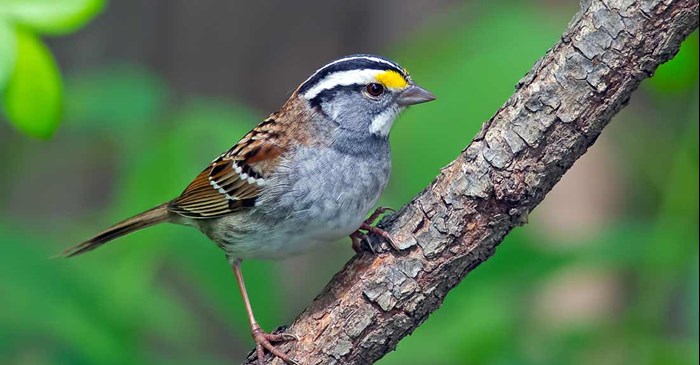The White-throated Sparrow is different than other songbirds that come to your feeder. This sparrow comes in two distinct color types. The first type of White-throated Sparrow has white stripes on its crown with bright yellow eyebrows that are called lores, while the second type sports tan stripes instead of white, and less vibrant lores. Both males and females come in either white or tan stripes, though the female’s plumage is a bit duller in appearance. And although this bird has two color forms, scientists have verified they are the same species.
Their physical differences are associated with personality differences. Tan-striped birds put more time into caring for their young. White-striped birds take on warrior tendencies, out-singing the tan birds, and they’re more likely to take an aggressive stance against invaders and rivals.
Opposites seem to attract for the White-throated Sparrow. Most of the time a white-striped bird mates with a tan-striped bird. However, males of both stripes might favor a more aggressive white-striped female, while both types of females might prefer a tan-striped attentive dad.
During the winter months, the White-throated Sparrow is common throughout the southern half of the U.S. In the spring, they migrate to New England, a far north segment of the Midwest and Canada to breed and nest. They construct their nests on or near the ground. However, if a predator gets to their eggs, they’ll make a second attempt, up in the branches of a pine tree.
After the breeding season, they’ll reform their flocks and forage for food together. Much of the time, you’ll find them hopping around, in the bushes and on the ground, foraging for seeds from grasses and weeds, along with berries and insects. Like other ground-based birds, they’ll use their beaks and feet to flick and scratch back leaves to find insects hiding beneath.
In spring listen for their sweet song ringing out: “Sweet Sweet Canada, Canada, Canada!”
White-throated Sparrows are frequent feeder visitors, preferring sunflower seeds and millet. To draw them in, opt for Lyric Supreme Wild Bird Mix with plenty of black oil sunflower seeds.
